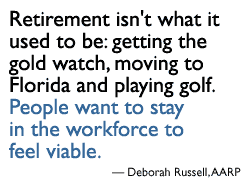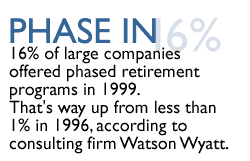|
Bridge to retirement
|
 |
March 8, 2000: 7:07 a.m. ET
Workers end careers gradually through phased retirement programs
By Staff Writer Jennifer Karchmer
|
NEW YORK (CNNfn) - At 63, college professor John O'Hara wasn't quite ready to close the drawer on his chalk and textbooks and say goodbye to the classroom.
He loved teaching at the University of Central Florida in Orlando for the past 20 years. So instead of quitting the rat race entirely and collecting a Social Security check, he scaled back his hours under the school's phased retirement program.
"I wasn't ready to go out to pasture," O'Hara said. "I didn't have a worldwide travel agenda and I didn't want to work on the world's greatest novel ... I wanted to stay busy, but not in the pressure cooker. This is a perfect transition."
Bridging the gap
John O'Hara isn't the only retiree building a bridge between his days in the classroom and his golden years. More and more companies are beginning to offer phased retirement programs as a way to hold trained and loyal employees.
"Retirement isn't what it used to be -- getting the gold watch, moving to Florida and playing golf," said Deborah Russell, senior program coordinator of economic security and work issues with AARP. "People want to stay in the work force to feel viable."

As Americans live longer in relatively good health, they feel they can offer the workplace more. Meantime, companies realize that the work force is getting older, and hiring younger, skilled workers is more difficult.
About 16 percent of large companies have a phased retirement program, according to the consulting firm Watson Wyatt. In 1996, less than one percent of large companies had such a program. Watson Wyatt expects the numbers to increase to around 33 percent in three to five years.
Thus, many older Americans are leaving the labor force gradually, moving from full-time employment to a variety of "bridge jobs" before they stop working altogether, according to Employee Benefit Research Institute (EBRI). In many cases, retirees want to continue to work to remain active. But the decision is also based on the need to pay bills.
Phase in
Whether it's through scaling back work hours, overseeing particular projects, or working as a mentor, phased retirement programs can differ among employers.
Click here for an example of a phased retirement program.
For example, the Florida Board of Regents oversees the phased retirement program at the University of Central Florida in Orlando, where John O'Hara has worked for two decades.
O'Hara began his phase retirement in January, after meeting the eligibility requirement of at least 10 years of service at the school. He officially retired from the school last Nov. 30 to fulfill the state requirement that he be off the school's payroll for at least 30 days before being rehired as an adjunct professor.

Then he had the choice to teach either part-time during both the fall and spring semesters, or teach full time during one semester.
Because he is considered officially retired from the school, his pension wasn't affected, yet he is eligible for part-time health benefits from the school.
There are many factors to keep in mind if you're thinking about easing your way out of your career and into the good life.
Remember to:
- get an assessment of your retirement package from your employer, including pension, health, and other benefits you may be expecting;
- weigh the pros and cons of both phased retirement and full retirement; and
- be aware of application requirements, such as length of employment or age
Above all, get an estimate of your upcoming Social Security benefits that could be affected if you continue to work. Lawmakers are currently deciding whether to do away with an earnings limit that prevents those between 65 and 69 from getting their full Social Security benefits if they make more than $17,000 a year.
O'Hara, who isn't currently collecting Social Security benefits, is keeping his fingers crossed that Congress passes the latest measure so he can continue to teach and collect his full benefits when he turns 65.
Public and private sectors
Private companies also offer phased retirement in a variety of forms. Varian Medical Systems in Palo Alto, Calif., which manufactures cancer therapies, has offered phased retirement for its employees for the last 20 years.
So whether it's in academia or a private corporation, employees may do some of the following to ease into retirement:
- work part-time through a reduced workday or work week;
- take part in a job transfer to test out a new site -- a company opening a new facility may use someone near retirement to act as a "seed" to try it out;
- do a job share with someone on maternity leave or disability; and/or
- work seasonally only during busy holiday cycles
"Companies are trying to hold onto these workers, and in many instances it's less expensive to retain them or retool their skills" than to hire new workers, said Valerie Paganelli, a senior retirement consultant at Watson Wyatt.
Phased retirement programs are most common among employers in the education sector such as universities and colleges, she added.
Best of both worlds
Retirement isn't an event; it's a process for many people, according to Joe Quinn, a former economics professor who has studied retirement patterns.
"Work provides more than just a paycheck -- it's a feeling of self-worth," said Quinn, who is the Dean of the College of Arts and Sciences at Boston College.
So when John O'Hara, the college professor, decided to scale back his work schedule and ease into retirement, he believed he was in the catbird seat.
"I've got the better part of both worlds," he said. "I'm continuing to be productive in my profession and enjoying the fellowship with my colleagues. But yet I'm able to expand my interests in my church, with my grandchildren, and other community affairs." 
|
|
|
|
|
 |

|

